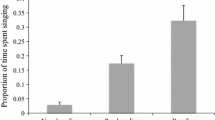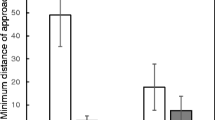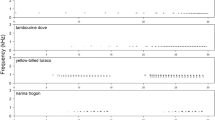Abstract
Mating tactics in species with facultative polygyny seem to be very flexible and to depend on local environmental conditions. We analysed the habitat and population contexts of territorial behaviour, associated with polygyny, in a population of Sedge Warblers Acrocephalus schoenobaenus inhabiting natural wetlands. Nearly one-third of all breeding males (46 individuals) resumed song after completing their mating with the first female, in order to attract another one. Resuming males were usually the earliest arrivals. There was a continuity in the territorial behaviour between resuming song on first territory and polyterritorial behaviour. Fifty-nine percent of resuming males set up second territories, clearly separated from the first. The second territory was usually located close to the primary female activity area. The quality of the first and second territories were correlated, with second territories being significantly inferior. However, their quality was not significantly different from the territories of non-breeding males. The quality of the second territories was also negatively related to the distance from the first territories. Polyterritorialism was influenced by population numbers: the higher the number of territorial males, the lower the number of second territories settled and the lower their average quality. Although the polygyny frequency in the studied population was very low, polyterritorial males were significantly more likely to be polygynous. We concluded that polygyny frequency can be significantly influenced by population numbers, which might be one of the main factors responsible for the variability in the mating system in this species.



Similar content being viewed by others
References
Adams ES (2001) Approaches to the study of territory size and shape. Annu Rev Ecol Syst 32:277–303
Alatalo RV, Lundberg A (1984) Polyterritorial polygyny in the pied flycatcher Ficedula hypoleuca––evidence for deception hypothesis. Ann Zool Fenn 21:217–228
Bielański W, Solarz W, Zając T (2005) Patch size effect on habitat loss in sedge warbler Acrocephalus schoenobaenus in the middle Nida Wetlands (S Poland). Nat Conserv 61:43–53
Borowiec M (1999) Breeding biology and ecology of Wrocław population of sedge warbler (Acrocephalus schoenobaenus). Reproductive behaviour and evolutionary strategies of males and females. Prace Zoologiczne 33, Univ Press Wrocław, Poland
Both C (2002) Fitness costs of polygyny in female pied flycatchers Ficedula hypoleuca. Ardea 90:129–138
Catchpole C, Leisler B, Winkler H (1985) Polygyny in the great reed warbler, Acrocephalus arundinaceus: a possible case of deception. Behav Ecol Sociobiol 16:285–291
Dyrcz A (1988) Mating systems in European marsh-nesting passeriformes. In: Quellet H (eds) Acta XIX congressus internationalis ornitologici, vol. II, University of Ottawa Press, Ottawa, pp 2613–2623
Ford N L (1996) Polyterritorial polygyny in North American Passerines. J Field Ornithol 67:10–16
Forstmeier W, Kuijper DPJ, Leisler B (2001) Polygyny in the dusky warbler, Phylloscopus fuscatus: the importance of female qualities. Anim Behav 62:1097–1108
Garamszegi LZ, Török J, Michl G, Møller AP (2004) Female survival, lifetime reproductive success and mating status in a passerine bird. Oecologia 138:48–56
Getty T (1997) Deception: the correct path to enlightenment? Trends Ecol Evol 12:159–160
Gustafsson L, Qvarnstrom A (2006) A test of the “Sexy Son” hypothesis: sons of polygynous collared flycatchers do not inherit their fathers’ mating status. Am Nat 167:297–302
von Haartman L (1969) Nest-site and evolution of polygamy in European passerine birds. Ornis Fenn 46:1–12
Hansson B, Bensch S, Hasselquist D (1997) Infanticide in great reed warblers: secondary females destroy eggs of primary females. Anim Behav 54:297–304
Hasselquist D, Langefors A (1998) Variable social mating system in the sedge warbler, Acrocephalus schoenobaenus. Ethology 104:759–769
Krebs J R (1971) Territory and breeding density in the Great Tit, Parus major L. Ecology 52:2–22
Król W, Solarz W, Zając T (2002) Breeding biology of sedge warbler Acrocephalus schoenobaenus in the river Nida wetlands (Poland). Biologia 57:617–625
Leisler B, Winkler H, Wink M (2002) Evolution of breeding systems in Acrocephaline warblers. Auk 119:379–390
Ligon JD (1999) The evolution of avian breeding systems. Oxford Ornithology Series 10, Oxford University Press, New York
Møller AP (1990) Changes in the size of avian breeding territories in relation to nesting cycle. Anim Behav 40:1070–1079
Møller AP, De Lope F, Saino N (2004) Parasitism, immunity and arrival date in migratory bird, the barn swallow. Ecology 85:206–219
Orians GH (1969) On the evolution of mating systems in birds and mammals. Am Nat 103:589–603
Pulliam RH, Danielson BJ (1991) Sources, sinks, and a habitat selection: a landscape perspective on population dynamics. Am Nat 142:42–58
Ratti O, Alatalo RV, Kilpimaa J, Siikamaki P (1995) Does female–female aggression explain male politerritoriality in the pied flycatcher ? A reply to Slagsvold and Dale. Anim Behav 50:850–853
Slagsvold T, Dale S (1995) Polygyny and female aggression in the pied flycatcher: a comment on Ratti et al. Anim Behav 50:847–849
Smith HG (1995) Experimental demonstration of a trade-off between male attraction and parental care. Proc R Soc Lond B 260:45–51
Svensson L (1992) Identification guide to European passerines 4th edn. L Svensson, Stockholm
Temrin H (1984) Why are some wood warbler (Phylloscopus sibilatrix) males polyterritorial? Ann Zool Fenn 21:243–247
Temrin H, Arak A (1989) Polyterritoriality and deception in passerine birds. Trends Ecol Evol 4:106–109
Verner J, Willson MF (1966) The influence of habitats on mating systems of North American passerine birds. Ecology 47:143–147
Yasukawa K, Searcy WA (1982) Aggression in female red-winged blackbirds: a strategy to ensure male parental investment. Behav Ecol Sociobiol 11:13–17
Zając T, Solarz W (2004) Low incidence of polygyny revealed in a long term study of the sedge warbler Acrocephalus schoenobaenus in natural wetlands of the S Poland. Acta Ornithol 39:83–86
Zając T, Solarz W, Bielański W (2006) Adaptive settlement in sedge warblers Acrocephalus schoenobaenus––focus on the scale of individuals. Acta Oecol 29:123–134
Acknowledgments
We are grateful to all those who took part in the field work, and in particular to Aleksandra Gondek, Wiesław Król, Bartek Pirga and Małgorzata Strzałka. Paweł Adamski, Mariusz Cichoń, Andrzej Dyrcz and Paweł Olejniczak provided invaluable comments. This study complies with the current laws of the Republic of Poland and has been funded by grants from the Polish State Committee for Scientific Research, no. 6P04F06412 and no. 6P04F02320.
Author information
Authors and Affiliations
Corresponding author
Additional information
Communicated by F. Bairlein.
Rights and permissions
About this article
Cite this article
Zając, T., Bielański, W. & Solarz, W. On the song resumption, polyterritorial behaviour and their population context in the Sedge Warbler Acrocephalus schoenobaenus . J Ornithol 149, 49–57 (2008). https://doi.org/10.1007/s10336-007-0211-8
Received:
Revised:
Accepted:
Published:
Issue Date:
DOI: https://doi.org/10.1007/s10336-007-0211-8




